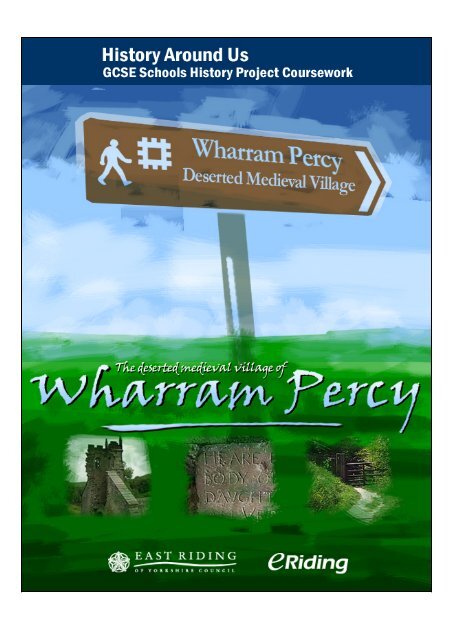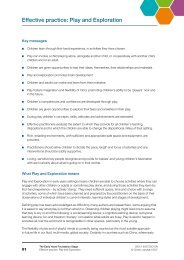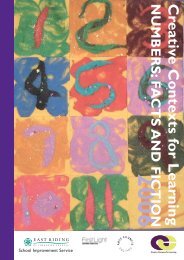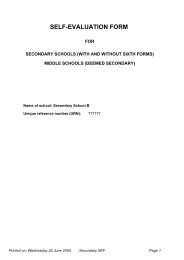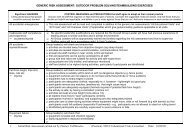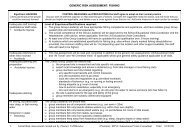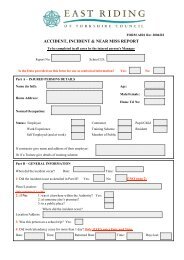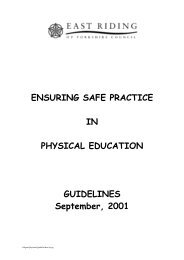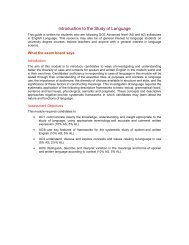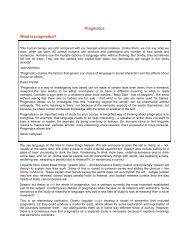GCSE Coursework: History Around Us - eRiding
GCSE Coursework: History Around Us - eRiding
GCSE Coursework: History Around Us - eRiding
Create successful ePaper yourself
Turn your PDF publications into a flip-book with our unique Google optimized e-Paper software.
<strong>History</strong> <strong>Around</strong> <strong>Us</strong> – The deserted medieval village of Wharram Percy1. IntroductionThis guide is written for learners and teachers who are preparing coursework for assessment on <strong>GCSE</strong>specifications that follow the Schools’ <strong>History</strong> Project in the UK.The <strong>History</strong> <strong>Around</strong> <strong>Us</strong> section of your <strong>GCSE</strong> course allows you to study history through relating thevisible remains and features of an historical site to its wider historical context. This will involve you invisiting a site and engaging in some “hands on” history as you collect and interpret evidence in order totest the hypothesis that has been set through your coursework question(s). The important thing toremember is that the coursework asks you to engage in a personal investigation of the site and yourschool will arrange for you to take part in a visit to the site that has been chosen for your courseworkhowever, it is always very useful to try and visit the site yourself as this will allow you extra time toinvestigate the site thoroughly. This coursework guidance will use a study of the deserted medievalvillage at Wharram Percy in the East Riding of Yorkshire as an example of how you could develop andpresent your <strong>History</strong> <strong>Around</strong> <strong>Us</strong> coursework.Good coursework will clearly show how the evidence you have collected from the site proves ordisproves the original hypothesis. For instance, you may have been asked to investigate whetherWharram Percy represents a typical medieval village. In order to reach your conclusion, you will have touse evidence about the layout of the village and its buildings and check it against other medieval villages.This would involve you in using a range of evidence including• maps,• village plans,• photographs of the site and• reconstructed drawingsYou will use these to conduct a full investigation of the site.When you are on the site you should• ask your teacher and other students as many questions as possible and• look for evidence of changes and evidence of features that may be atypical (not typical) of, or uniqueto, that particular site.Before you visit the site you should have spent some time studying the historical context of the site. Forexample, if you are visiting a medieval castle you will have spent some time studying the development ofcastles in Britain between 1066 and 1550. During your visit you will be looking for evidence of how yourparticular castle does or does not reflect that general history of development.You may also reflect on why it is or is not typical of what you have found elsewhere. Does it follow therule or is it the exception that is said to prove the rule? This means that a good rule will both be truegenerally, but will have a small number of exceptions – which often illustrate some other rule.It is important that when you are taking photographs or making sketches that you keep in mind thecoursework task you will do later. This may help you collect relevant evidence that you can then use inyour answers to the coursework tasks. But it is better to collect more evidence than you need, and selectfrom it later, than find you do not have what you need to make a detailed study.3© <strong>eRiding</strong> 2004
<strong>History</strong> <strong>Around</strong> <strong>Us</strong> – The deserted medieval village of Wharram Percy2. <strong>Us</strong>ing a ChecklistYou could begin by gathering together a checklist of the typical features of the type of site/building youare investigating. You can use this to cross-reference these general features with the evidence from thesite you are visiting. For example if you coursework involved a study of how far Wharram Percyrepresents a typical medieval village you could construct a chart similar to the one shown below:A typical medieval village has• A mill to grind corn and othercereals grown in the village• A stone church with agraveyardEvidence from Wharram Percy• Wharram Percy had a water mill until the 13 th century. Youcould consider how typical water mills were in medievalvillages.• A small stone church was built in the village in Saxon times.The church was rebuilt in 12 th century and it was made muchlarger, as the builders added a west tower and an apse at theeast end. During the 15 th century the builders made thechancel longer and added a south aisle chapel. The buildingwas re-roofed and the top of the tower was changed. Thechurch fell into disuse by the early 20 th century. Part of thetower collapsed and the roof was removed in 1959. Thegraveyard was in use from 8 th to the early 20 th century.• A stone manor house • Wharram Percy had two manor houses, the North and SouthManor. The South Manor buildings were dismantled in the 13 thcentury.• Open fields • Open fields surround Wharram Percy, and there is evidence ofstrip farming having taken place.• Peasant houses made of mud,wood and thatch,approximately 10m x 5m insize.• Foundations of the houses were made from chalk rubblequarried from within the village area. The walls and roof wereconstructed from curved tree trunks (the peasant houses werecruck framed houses). The walls were constructed from wattleand daub. Peasant houses had a thatched roof. Housesvaried in size. Each house had a garden.• A pond • Wharram Percy has a pond that was created by damming thebeck. During the 13 th century it was stocked with fish.4© <strong>eRiding</strong> 2004
<strong>History</strong> <strong>Around</strong> <strong>Us</strong> – The deserted medieval village of Wharram Percy3. Setting <strong>Coursework</strong> TasksA study of Wharram Percy would allow your teacher to set tasks that fulfil many of the areas suggested inthe coursework guidance provided by the exam boards. A study of Wharram Percy would allow you tostudy the site in the context of one of the following suggested areas:• Prehistoric Britain – it would be possible to look at the evidence of early settlement at the site inthe context of prehistoric Britain (the time before written records began). This could lead you toinvestigate how typical Wharram Percy is as evidence of a prehistoric settlement.• Roman Britain – there were at least five farms in the valley in the Roman period and fragments ofwindow glass found on the North Manor site suggest that there was a Roman villa nearby. Theaerial photographs of the area also show the remains of a 1 st century AD farm.• Castles and fortified houses, 1066-1550 – the coursework tasks could focus on an investigationof the North and South Manor houses in the context of how typical they are as examples offortified medieval manor houses.• Church buildings and furnishing, 1066-1550 – St Martin’s Church and its graveyard haveundergone extensive investigation and would provide a useful focus for coursework tasks as thesite provides evidence of change between 1000 and 1910.• Studies in the making of the rural landscape – a study of Wharram Percy would provide evidenceof the changes that occurred as a result of the shift from arable to sheep farming in the latemiddle ages. The site has a long history of agricultural occupation from 700 BC to the 20 thcentury and it would be possible to investigate how far these changes reflect the pattern ofagricultural development in the Wolds and in Britain as a whole.• Aspects of the historical development of the locality – a study of Wharram Percy in the context ofthe development of settlement in the Wolds. It would be possible to consider why Wharram Percywas abandoned, when the neighbouring village of Thixendale continues to survive.5© <strong>eRiding</strong> 2004
<strong>History</strong> <strong>Around</strong> <strong>Us</strong> – The deserted medieval village of Wharram Percy4. <strong>Us</strong>ing the Visible RemainsThe purpose of this piece of coursework is to allow you to take part in a personal investigation of thevisible remains of an historical site. The coursework task does not require you to write a description ofthe site. If you just write a description of the site it will be impossible for you to gain grade C or above.Grade A* to C coursework involves students in testing a hypothesis or an investigation of historicalinterpretations or representations of the site. You need to remember this when you are investigatingthe site; you will be using the visible remains to prove or disprove a hypothesis or interpretation orrepresentation of the site.4.1 Interpreting Historical RepresentationsYou could, for example, be asked to investigate the accuracy or reliability of an historical representationof the site by using the evidence from the visible remains. Many sites have aspects of reconstruction orreconstruction drawings exist of the site. You could be asked to test the accuracy or reliability of thesereconstructions or drawings, like the pictures of Wharram Percy shown below. An artist produced boththese drawings in the 20 th century. They show images of the church and North Manor house at WharramPercy. You would need to look for evidence on the site to test the accuracy and reliability of theseimages. To conduct a successful investigation it is a good idea to think of a list of questions you wouldlike to ask about the pictures. This can help you to focus your investigation when you visit the site.• How does the artist know about thesize and shape of the peasant housesand the church?• What stage of the history of the villagedo the drawings represent?• Which parts of the drawings have comefrom the artist’s imagination?• Where are the millpond and the streamin relation to the church?6© <strong>eRiding</strong> 2004
<strong>History</strong> <strong>Around</strong> <strong>Us</strong> – The deserted medieval village of Wharram Percy4.2 Wharram Percy From The AirWhen you visit the site, you may find it hard to see the remains of the old village around you. The siteshows some of these features more clearly from the air. You are not likely to have this view, but you canuse the aerial photograph below to look for evidence of the mediaeval settlement, and laterdevelopments on the site.Remains of the trackpassing the pond andthe churchSt Martin’s ChurchRemains of the openfieldsRemains of thepeasant housesThe cottages from the18 th centuryThe mill-pond andwater millRemains of the tracks thatran through the villageYour study will need to include descriptions and analyses of specific areas of the village to prove ordisprove your theories and this will involve you in being able to interpret the visible remains of the villageand place them in their historical context. One way to do this will be through including well-annotatedphotographs and drawings of parts of the village. For example you may want to use photographs of thechurch to record the changes that took place in the village between the 10 th and 16 th centuries.7© <strong>eRiding</strong> 2004
<strong>History</strong> <strong>Around</strong> <strong>Us</strong> – The deserted medieval village of Wharram Percy4.3 The Church of St Martin and the Graveyard4.3.1 Some Background InformationThe Church of St Martin at Wharram Percy was the first complete excavation of a medieval church inBritain. The excavations took place between 1962 and 1974 and the archaeologists were able to build adetailed picture of the changes in shape and size that took place at St Martin’s over a period of 1000years.The Church played a very important part in the lives of medieval people. This importance is shown by thefact that churches were built in stone when many other medieval buildings were built in wood. The churchwas added to and enlarged between the 10 th and 16 th centuries. This also reflects its importance to thevillagers at Wharram Percy. Churches played a central role in medieval villages: they were the mainmeeting place in the village, fairs and markets were held in the churchyards and the priest often settledlegal disputes and managed wills. Medieval people were proud of their churches and devoted great careand attention to their upkeep and improvement. Villagers would often leave precious objects and smallsums of money in their wills to the church in order to gain the priest’s prayers for themselves and theirancestors to ease their way through purgatory and ensure their places in heaven.The archaeologists’ excavations showed that the first stone church was built on the site in the 11 thcentury. However, they believe that the church site was a holy place long before Christianity came toBritain. Before the Romans came to Britain the Celts had worshipped water and there is evidence thatthere were farms in the valley during the Bronze and Iron Ages. It is possible that the Bronze and IronAge farmers worshipped the springs that run through the valley and the archaeologists have found theremains of a Celtic burial mound in the graveyard.The graveyard has been excavated and nearly 1000 skeletons of men, women and children have beendug up and examined. Most of these skeletons are the remains of farmers who lived at Wharram Percybetween 1000 AD and 1500 AD. Most of these bodies had no grave markers; in the past only the veryrich had grave memorials. The gravestones that remain in the graveyard are from the 18th and 19 thcenturies and mark the graves of wealthy tenant farmers who lived in the valley.The evidence of the skeletons has provided very useful information about the people who lived atWharram Percy. The skeletons tell scientists of the diseases the people suffered from and the length oftheir lives.Over half the skeletons excavated are of babies and young children. This suggests that during the periodwhen the cemetery was in use, fewer than half of the village’s people survived to be adults. (It is possiblethat more survived, but were buried somewhere else – which could happen if they left the village to liveand work elsewhere.)If all the people born in Wharram Percy are also buried there (which is very likely), then we can say thatonly about half of them reached the age of 18. Many of the bones show evidence of arrested growth; thismay have resulted from starvation when crops failed. The bones also show that the average 14 th century15 year old at Wharram Percy reached the height of an average 10 year old of today. One possibleexplanation is that the frequent food shortages caused young people not to grow to their full potential.We could check this by looking at skeletons of more wealthy people, to see if they grew taller onaverage.8© <strong>eRiding</strong> 2004
<strong>History</strong> <strong>Around</strong> <strong>Us</strong> – The deserted medieval village of Wharram Percy4.3.2 The TowerThis is a perpendicularGothic window. Thisdesign was usedbetween 1375 AD and1530 AD.The tower was rebuiltand made higher in 15 thcentury.This was the roofline ofthe 12th century tower.This shows evidence ofchange to the site.The remains of arcadingbuilt in the 15 th century.This is a roundedRomanesque arch. TheRomanesque style waspopular between the 11thand the 12th centuries;this suggests that thispart of the tower wasbuilt before 1200 AD.The photograph above shows the likely appearance of the tower by 1450. During the 15 th century thewhole building was re-roofed and the top stage of the tower was rebuilt in its present form. Of course, inthe 15 th Century, anyone standing in the position from which, centuries later, this photograph was takenwould not see the whole tower – as the church ceiling would be in the way…• Why was the tower rebuilt?Questions or prompts for further discussion• Is the design of the tower typical of the 15 th century?• Why was arcading built in the early 15 th century only to be demolished by the late 15 th /early 16 thcentury?• Was the church changed as a result of the English Reformation in the 16 th century?• Why did people continue to make changes to the church after the village was deserted?9© <strong>eRiding</strong> 2004
<strong>History</strong> <strong>Around</strong> <strong>Us</strong> – The deserted medieval village of Wharram Percy4.3.3 A Window and GargoylesThis is a decorated Gothicwindow. This style ofwindow was popularbetween 1275 AD and1375 AD.These are gargoyles. Theyoften represented localpeople or famous people ofthe time e.g. kings or lords.Some historians have also suggested that gargoyles represent a link with the pagan traditions peoplehad before the Christian era as the head often became an object to be worshipped or feared. Many earlyreligions involved the production of the representations of heads to represent or ward off spirits.A popular gargoyle that can be found on many churches is the Green Man and this links back to anancient pagan tradition that was so powerful that it survived the growth in Christian belief. It is alwaysinteresting to look for carvings of the Green Man when you are investigating churches. More informationabout the Green Man and gargoyles can be found at:• http://www.mikeharding.co.uk/greenmanQuestions or prompts for further discussion• It would be interesting to try and identify who is being represented in the gargoyles this may tellyou something about the villages attitudes towards local lords and figures from the nationalgovernment e.g. the king and his ministers.10© <strong>eRiding</strong> 2004
<strong>History</strong> <strong>Around</strong> <strong>Us</strong> – The deserted medieval village of Wharram Percy4.3.4 Investigating Changes to the Church WallsType your text here.Type your text here.Type your text here.St Martin’s underwent a number of changes during its 900 year history and many of this can been seenwhen making a careful examination of the interior walls. The photograph above shows some of thechanges that were made when the interior was remodelled in the 15 th and 16 th centuries. The pictureabove shows evidence of the arcading that was added to the church in the 15 th century and the blockingof the arcades that took place in the 16 th century.Was this change typical of what was happening in English churches during the 16 th century or were thechanges made for purely local reasons?11© <strong>eRiding</strong> 2004
<strong>History</strong> <strong>Around</strong> <strong>Us</strong> – The deserted medieval village of Wharram Percy4.3.5 Comparing Two WindowsThis picture would provide you with useful evidence about some of the changes that have taken place atthe church between 1000 and 1500. You can clearly see differences in the shape and design of thewindows and this will help you to describe and date the changes that have taken place.The photograph below clearly shows two different styles of window and the arches above them. The styleof the arches will help you to date when the changes were made. Careful examination of the stoneworkalso shows that changes have been made to shape, size and height of the windows. You can find moreinformation about Medieval Churches and Architecture at• http://www.britainexpress.com/<strong>History</strong>/Medieval_art_and_architecture.htmTraceryThis is a decoratedGothic window(1275 AD- 1375AD). These windowswere wider than theNorman windows,andwereornamentedThis is a Norman Gothic window (1066-1200 AD).The decoration of windows was simple and similarto the Romanesque style.The original window was higher and narrower and had amore rounded shape at the top. Narrow windows withrounded arches were a feature of the Romanesque period.The newer decorated window (right) is beneath/inside a more rounded Romanesque style of arch. Thissuggests that when the villages made changes to their church between the 13 th and the 15 th century theywere aware of changes of fashion in church architecture and wanted to modernise their church inresponse to architectural trends.At the time that the changes to the windows were made the church was undergoing a major perioddevelopment that led to the church’s being extended and the tower heightened. The strange thing is thatat the time that these major changes were taking place the population of the village was declining. Thisshows that the church was not only important to the people who lived at Wharram Percy but to people inthe surrounding villages for example Thixendale, which did not have a church and people continued touse St Martin’s Church long after the last four families were evicted from Wharram Percy in 1500.12© <strong>eRiding</strong> 2004
<strong>History</strong> <strong>Around</strong> <strong>Us</strong> – The deserted medieval village of Wharram PercyThis perhaps reflects the site’s importance as a place of worship and local people may have believed thatthe site was holy. Certainly archaeological evidence suggests that the site occupied by St Martin’sChurch and Graveyard had been a place of worship in the pre-Christian era and it was common forchurches to be built on ancient sacred sites, as the local people often believed that these areas werespecial.4.3.6 Masons’ MarksMasons made these marks on thechurch wall. The stonemasonswho shaped the stones often leftevidence about themselves byleaving marks on the stones. Mostof them could not write and themarks were their way of leavingtheir signatures on the stones.Questions or prompts for further discussion• What do the marks suggest about the masons who made them?• You could look for further evidence of mason’s marks on the site. What would this evidencesuggest to you about the construction of the church at Wharram Percy?13© <strong>eRiding</strong> 2004
<strong>History</strong> <strong>Around</strong> <strong>Us</strong> – The deserted medieval village of Wharram Percy4.3.7 Changes in the BuildingHere you can see clearly somechanges in the building of thechurch. The stone is different ineach section. The original churchhas been made wider and longer,these changes took placebetween 1200 AD and 1500 AD.Questions or prompts for further discussion• Why was the church been made wider and longer?• Was there a growth in the population or wealth of the village?• Were the changes made in response to changes in architectural fashions?• Was the local lord or landowner responsible for the changes or did the villagers play a part inexpanding their church?• Why were the changes made at that particular stage in the history of the village?• What do the changes to the church suggest to us about the importance of churches in medievalvillage society?14© <strong>eRiding</strong> 2004
<strong>History</strong> <strong>Around</strong> <strong>Us</strong> – The deserted medieval village of Wharram Percy4.3.8 The Base of the FontThis is the base of the font. Thefont was a container, generallymade of stone, which containedthe holy water for baptism. Itwas usually located near thewest door. The font from StMartin’s dates from AD 1200. Itis now kept in the church of StMichael and All Angels, Hull.The last baptism at WharramPercy took place in 1946.Questions or prompts for further discussion• Why were baptisms still being held in the church long after the village was deserted?• What do the physical remains of the font suggest about its size and shape?• Is the location of the font near the west door a typical feature of medieval churches?15© <strong>eRiding</strong> 2004
<strong>History</strong> <strong>Around</strong> <strong>Us</strong> – The deserted medieval village of Wharram Percy4.3.9 Questioning a Modern ReconstructionConsider whether the picture below is an accurate reconstruction of St Martin’s Church and graveyard.After studying the photographic evidence you could question the accuracy of this drawing. Among otherthings, you need to consider what period in the history of the church and the village this drawing isdesigned to represent.This is an apse – the domed orvaulted east end of the church.In Britain it was more usual tohave a square rather than arounded apse. Rounded apseswere more popular on thecontinent. What does thissuggest to you about the peoplewho designed and built StMartin’s Church?Questions or prompts for further discussion• Look carefully at the tower of the church, how does the tower in the reconstruction differ from theremains of the tower in the photographic evidence?• Do the differences mean that the artist’s drawing is an unreliable source of evidence aboutWharram Percy?• What questions would you have to ask to test the reliability/usefulness of the artist’sreconstruction?• An interesting point to consider is the church’s location in the village. The church is located awayfrom the peasants’ houses and is at the opposite end of the village from the manor houses. Wasthis typical of medieval villages or is this feature unique to Wharram Percy?16© <strong>eRiding</strong> 2004
<strong>History</strong> <strong>Around</strong> <strong>Us</strong> – The deserted medieval village of Wharram Percy4.4 Further Ideas for Interpreting EvidenceYour coursework may well focus on investigating the reasons why the village was deserted. This willrequire you to use evidence from the site and other sources of evidence to substantiate your theories.For example the changes made to the church during the 15 th century could be used to support the theorythat the village was not deserted as a result of the effects of the Black Death in 1349. This used to be apopular theory used to explain the desertion of many medieval villages.Why was Wharram Percy abandoned? Hypotheses and evidence trails.Follow the evidence trails to reach a substantiated conclusion about why the village was deserted.Remember you must use evidence from the site and from the historical records to support your theories.This guide contains examples of historical evidence that may support or challenge the hypotheses. Forthe first few there are several examples. For the later hypotheses, there are fewer. This does not meanthat there is no historical evidence, but you may have to look further for it.17© <strong>eRiding</strong> 2004
<strong>History</strong> <strong>Around</strong> <strong>Us</strong> – The deserted medieval village of Wharram PercyHypothesis 1: The village was abandoned because of the Black Death (bubonic plague) in 1349.Evidence forThe population of the village fell.The Lord of the Manor, William de Heslerton, diedof the plague in 1349.The village priest died of the plague in 1349.The water mill was no longer being used (thismight be a precaution against infection).Evidence againstBy 1368 the number of houses in the village hadincreased to 30.By 1368 a corn barn, common oven and kiln werein use.Historical evidence about the effects of the Black Death on BritainChronicle of Louth Park Abbey, written in 14 th centuryIn the year of our Lord, 1349, the hand of God struck the human race a deadly blow. This scourge inmany places left less than one fifth of the population surviving. It struck terror into the hearts of the wholeworld. So great a pestilence had never been seen or heard or written of before this time. So huge anumber was not even swept away by the flood that happened in the days of Noah.Court Roll of the Manor of Sladen, Buckinghamshire, 1349A jury in August 1349 declared under oath that the mill was of no value, for not only was the miller dead,but there were no tenants who wanted to grind any corn. The total rents of the freemen and serfs in theprevious year (1348) amounted to £12. In this year (1349) nothing had been collected and the land wasnot being farmed.Other evidence--Put your own examples of evidence in this box--18© <strong>eRiding</strong> 2004
<strong>History</strong> <strong>Around</strong> <strong>Us</strong> – The deserted medieval village of Wharram PercyHypothesis 2: The village was abandoned in the 16 th century because sheep farming becamemore profitable than arable farming.Evidence forThe Hilton family became owners of the village in 1403 andbegan to convert the land from arable to sheep farms.In 1500 four families were evicted from Wharram Percy andtheir houses were pulled down.Many of the objects found at Wharram Percy byarchaeologists are made from sheep and cattle bones.By 1500 England’s most important export was woollencloth. This is symbolised by the fact that the LordChancellor continues to sit on a woolsack in the House ofLords.Evidence againstA farm remained in the valley in 1573.The church and graveyard continued to beused.In the late 1700s a new farmhouse andoutbuildings were built and new farmingmethods introduced.Evidence about the importance of sheep farming in late medieval and early modern BritainA school history textbook published in 1992More of the land in the village was used for animal farming. Sheep farming became very popular in manyareas. Fields that had once grown wheat or barley were often turned into grazing for sheep.From Cardinal Wolsey’s Commission of Inquiry, 1517He held this land on 2 nd March 1489 when those messages were laid waste and thrown down, and landsformerly used for arable he turned over to pasture for animals, so three ploughs are now out of use there,and 18 people who used to work on that land and earn their living there and who dwelled in the houseshave gone away to take to the roads in their misery, and seek their bread elsewhere and so are led intoidleness.An Act of 1489 made it an offence to convert open fields in to pasture if it involved the removal ofsmallholdings over 20 acres.Great inconveniences daily do increase by desolation and pulling down and wilful waste of houses andtowns within the King’s laying to pasture lands which have been customarily used in tillage. Idleness, thecause and beginning of all mischiefs, daily increases where in some towns 200 persons were occupiedand lived by their lawful labours, now they are occupied by 2 or 3 herdsmen.From Sir Thomas More’s book ‘Utopia’ written in 1516There are noblemen, gentlemen, and even some abbots, though otherwise holy men, who are notsatisfied with the annual revenues and profits that their predecessors used to derive from their estates.They are not content to do no good to their country; they must do it positive harm. They leave no groundto be tilled; they enclose every bit of land for pasture; they pull down houses and destroy towns, leavingonly a church to pen the sheep in. And, as if enough English land were not wasted on ranges andpreserves of game, those good fellows turn all human habitations and all cultivated land into awilderness… A single shepherd or herdsman is sufficient for grazing livestock on that land for whosecultivation many hands once required to make it raise crops.19© <strong>eRiding</strong> 2004
<strong>History</strong> <strong>Around</strong> <strong>Us</strong> – The deserted medieval village of Wharram PercyOther evidence--Put your own examples of evidence in this box--20© <strong>eRiding</strong> 2004
<strong>History</strong> <strong>Around</strong> <strong>Us</strong> – The deserted medieval village of Wharram PercyHypothesis 3: The village was abandoned because the villagers were afraid of being attacked byScottish raiders in the 14 th century.Evidence forIn the 14 th century Scottish raiders destroyed anumber of Northern villages.Scottish raiders burnt Thixendale, a neighbouringvillage to Wharram Percy.Evidence againstWharram Percy was not attacked when Thixendalewas burned.People continued to live in the village after the 14 thCentury.Evidence about Border RaidersStatement by Maxine Squire, UK teacher of history, 2005Many families who lived on the borders between England and Scotland took to reiving. This means thatthey began to organise raids into England to steal cattle and crops to feed themselves and their families.Scottish reivers attacked villages as far south as Yorkshire. They struck at night when they had goodcover and tended to go on raids between August and February after the harvest had been collected in,and during the time when the courts were in recess. This meant they had a good chance of escapingdetection and punishment.Other evidence--Put your own examples of evidence in this box--21© <strong>eRiding</strong> 2004
<strong>History</strong> <strong>Around</strong> <strong>Us</strong> – The deserted medieval village of Wharram PercyHypothesis 4: The village was abandoned because there was a shortage of water on the site.Evidence forWater is a rare commodity on the Wolds:streams often flow underground beneath thechalk.Dams had to be built at Wharram Percy fromthe 9 th Century AD. This created a pondwhere people collected water for cooking anddrinking and watered their animals. Thewater was also used to power the mill.By the 12 th or 13 th century the water mill hadto be abandoned.Evidence againstThe Beck at Wharram Percy is fed by undergroundsprings.The pond is still at Wharram Percy, filled with water.Farmers regularly repaired the dam until the 19 th century.Water from the springs was still being used to supplyother settlements until 1935.During the construction of the Burdale railway tunnel inthe 1850s a pumping engine had to be set up to pumpwater from underground to allow the tunnel to be built.You can use an Ordnance Survey Map to find more evidence about the availability of water at WharramPercy, and the possibilities of storing it.In the past, many people and animals used the pond. This does not happen today, so the reduced usemay affect the volume of water that you will see there on a visit.Other evidence--Put your own examples of evidence in this box--22© <strong>eRiding</strong> 2004
<strong>History</strong> <strong>Around</strong> <strong>Us</strong> – The deserted medieval village of Wharram PercyHypothesis 5: The village was abandoned because local landowners weren’t interested in thevillage.Evidence forFrom 1573 to 1636 the village was owned bya series of absentee landlords.The land began to be leased to tenantfarmers.Evidence againstIn 1775 Sir Charles Buck bought the land and began tomake improvements.The church and its graveyard continued to be used until1910.Evidence about landownersFrom Christopher Hill, The English Revolution, 1940The northern and western parts of England remained relatively untouched by the new commercial spiritradiating from London and the ports; but in the south and east many landowners were beginning toexploit their estates in a new way. Both in the Middle Ages and in the seventeenth century the firstimportance of an estate was that it supplied a landowner (through his control over the labour of others)with the means of livelihood. But over and above this, the large estates had in the Middle Agesmaintained with their surplus agricultural produce a body of retainers who would on occasion act assoldiers, and so were the basis of the political power of the feudal lords.Now, with the development of the capitalist mode of production within the structure of feudalism, manylandowners began either to market that portion of the produce of their estates, which was not consumedby their families, or to lease their lands to a farmer who would produce for the market. So landownerscame to regard their estates in a new light: as a source of money profit, of profits that were elastic andcould be increased. Rents used to be fixed at levels maintained so long that they came to be regarded as“customary,” as having existed “from time immemorial”; so did the many extortionate legal charges whichfeudal landowners extracted from the peasantry; but now they were being “racked up” to fantasticallyhigh levels.http://www.marxists.org/archive/hill-christopher/english-revolution/Other evidence--Put your own examples of evidence in this box--23© <strong>eRiding</strong> 2004
<strong>History</strong> <strong>Around</strong> <strong>Us</strong> – The deserted medieval village of Wharram Percy5. Appendix: Assessment Objectives<strong>Us</strong>e this guidance to make sure you are doing what the examiners require you to do.This study of history from its visible remains affords opportunities for candidates to:i. describe, analyse and explain a chosen historical site (AO 6.1)ii. relate a chosen site to its broader historical context (AO 6.1)iii.use sources to investigate the historical site and/or its context, appreciating that the visibleremains of the past are themselves as important a resource for our understanding of history asdocumentary sources.(i) Setting coursework tasks on AO 6.1: Relating an historical site to its historicalcontext.The candidate must place the chosen site clearly in its historical context in order to show the part playedby the site in that context.The ability to explain features of the site, which are typical or atypical of the broader historical context, isa particularly useful assessment activity enabling candidates of all abilities to have access to the highestlevels of achievement. Presenting candidates with a hypothesis or question, which allows a personalanalysis of an issue, is likely to contribute to a successful coursework assignment.(ii) Setting coursework tasks on AO 6.2 and AO 6.3: <strong>Us</strong>ing sources to investigate anhistorical site.It should be appreciated that this coursework assignment is not a site description. The site must allowpersonal investigation and other forms of evidence must be available. The tasks set must involve anevaluation of the evidence provided by the site and the other sources, e.g. by the candidate assessingthe reliability, usefulness and limitations of the evidence.Tasks could take the form of a hypothesis for the candidate to check and verify with supporting evidence,or reject after testing for omissions and deficiencies in the evidence. Such a task could be planned andexecuted as part of a longer programme of work. A site description could be carried out beforehand butwould not necessarily form part of the <strong>GCSE</strong> assessment itself.An historical site will readily lend itself to work on historical interpretations and representations of some ofthe following are available: guidebooks, tape/slide presentations, model re-constructions engravings,paintings, etc. It may also be possible to use photographs, maps and plans, memoirs, diaries, censusreturns etc., as sources of evidence about the site. The list of possible sources and interpretations givenfor the Modern World Study may also be relevant for <strong>History</strong> <strong>Around</strong> <strong>Us</strong>.Information from a site can be recorded very successfully in the form of maps, plans, annotateddiagrams, photographs and sketches. If such techniques are used, they should be clearly integrated intothe assignment not merely appended to it. The most effective sketches, for example, are those that pickout particular features of a building to illustrate a particular point.24© <strong>eRiding</strong> 2004


